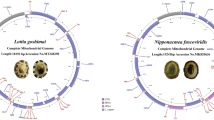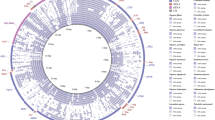Abstract
For several decades, both concerted evolution and non-concerted evolution of rRNA genes have been discovered in a wide variety of species. To explore the evolutionary patterns and to evaluate the variability at the intra-individual and interspecific levels in Soleidae, a total of 233 complete 18S-ITS1-5.8S rDNA sequences from 11 representative species were generated. The results indicated that six species had little variation, suggesting a concerted evolutionary pattern. However, in the other five species, much variation was observed. Two or three types of 18S and ITS1-5.8S, or even the entire 18S-ITS1-5.8S rDNA sequence, were identified, suggesting a non-concerted evolutionary pattern. According to the pseudogene identification criteria, Type B and C in the five species that underwent non-concerted evolution were postulated as pseudogenes. The phylogenetic analysis based on these rDNA sequences showed that some of the pseudogenes diverged from the corresponding species or even clustered with other species, and the potential causes for this are discussed. Further analyses of the pseudogenes revealed that they could also provide particular evolutionary information, suggesting that pseudogenes should be taken into consideration rather than being discarded arbitrarily. Moreover, the results provided molecular support for the inclusion of Pseudaesopia japonica in the genus Pseudaesopia, and not in Zebrias or other genera.




Similar content being viewed by others
References
Álvarez, I. & J. F. Wendel, 2003. Ribosomal ITS sequences and plant phylogenetic inference. Molecular Phylogenetics and Evolution 29: 417–434.
Bailey, C. D., T. G. Carr, S. A. Harris & C. E. Hughes, 2003. Characterization of angiosperm nrDNA polymorphism, paralogy, and pseudogenes. Molecular Phylogenetics and Evolution 29: 435–455.
Bargues, M. D., M. A. Zuriaga & S. Mas-Coma, 2014. Nuclear rDNA pseudogenes in Chagas disease vectors: evolutionary implications of a new 5.8S + ITS-2 paralogous sequence marker in triatomines of North, Central and northern South America. Infection, Genetics and Evolution 21: 134–156.
Bayly, M. J., F. Udovicic, A. K. Gibbs & P. Y. Ladiges, 2008. Ribosomal DNA pseudogenes are widespread in the eucalypt group (Myrtaceae): implications for phylogenetic analysis. Cladistics 24: 131–146.
Bleeker, P., 1860. Zesde bijdrage tot de kennis der vischfauna van Japan. Acta. Soc. Scient. Indo-Neerl. 8: 1–104, 2.
Brownell, E., M. Krystal & N. Arnheim, 1983. Structure and evolution of human and African ape rDNA pseudogenes. Molecular Biology and Evolution 1: 29–37.
Buckler, E. S., A. Ippolito & T. P. Holtsford, 1997. The evolution of ribosomal DNA: divergent paralogues and phylogenetic implications. Genetics 145: 821–832.
Chabanaud, P., 1934. Le complexe basisphenoi’dien et Ieseptum orbitaire des Poissons heterosomes. Comptes Rendus de Ácadémie des Sciences 198: 1875–1877.
Eschmeyer, W. N., R. Fricke, R. van der Laan (eds), 2017. Catalog of Fishes: Genera, Species, References (http://researcharchive.calacademy.org/research/ichthyology/catalog/fishcatmain.asp). Electronic version accessed 02.08.2017.
Gong, L., W. Shi, M. Yang, L. Si & X. Kong, 2016a. Long duplication of 18S ribosomal DNA in Cynoglossus lineolatus (Pleuronectiformes: Cynoglossidae): novel molecular evidence for unequal crossing over model. Acta Oceanologica Sinica 35: 38–50.
Gong, L., W. Shi, M. Yang, L. Si & X. Kong, 2016b. Non-concerted evolution in ribosomal ITS2 sequence in Cynoglossus zanzibarensis (Pleuronectiformes: Cynoglossidae). Biochemical Systematics and Ecology 66: 181–187.
Guindon, S., J.-F. Dufayard, V. Lefort, M. Anisimova, W. Hordijk & O. Gascuel, 2010. New algorithms and methods to estimate maximum-likelihood phylogenies: assessing the performance of PhyML 3.0. Systematic Biology 59: 307–321.
Günther, A. 1862. Catalogue of the fishes in the British Museum. Catalogue of the Acanthopterygii, Pharyngognathi and Anacanthini in the collection of the British Museum. British Museum, London, Vol. 4: 485
Hall, T. A., 1999. BioEdit: a user-friendly biological sequence alignment editor and analysis program for Windows 95/98/NT. Nucleic Acids Symposium Series, 95–98.
Harpke, D. & A. Peterson, 2008a. 5.8 S motifs for the identification of pseudogenic ITS regions. Botany 86: 300–305.
Harpke, D. & A. Peterson, 2008b. Extensive 5.8 S nrDNA polymorphism in Mammillaria (Cactaceae) with special reference to the identification of pseudogenic internal transcribed spacer regions. Journal of Plant Research 121: 261–270.
Hribova, E., J. Cizkova, P. Christelova, S. Taudien, E. de Langhe & J. Dolezel, 2011. The ITS1-5.8S-ITS2 sequence region in the Musaceae: structure, diversity and use in molecular phylogeny. PLoS ONE 6: e17863.
Jacq, C., J. Miller & G. Brownlee, 1977. A pseudogene structure in 5S DNA of Xenopus laevis. Cell 12: 109–120.
Jordan, D. S. & E. C. Starks, 1906. A Review of the Flounders and Soles of Japan, US Government Printing Office.
Kumar, R., M. Singh, B. Kushwaha, N. Nagpure, I. Mani & W. Lakra, 2013. Molecular characterization of major and minor rDNA repeats and genetic variability assessment in different species of mahseer found in North India. Gene 527: 248–258.
Kumar, S., G. Stecher & K. Tamura, 2016. MEGA7: molecular evolutionary genetics analysis version 7.0 for bigger datasets. Molecular Biology and Evolution 33: 1870–1874.
Larkin, M. A., G. Blackshields, N. P. Brown, R. Chenna, P. A. McGettigan, H. McWilliam, F. Valentin, I. M. Wallace, A. Wilm, R. Lopez, J. D. Thompson, T. J. Gibson & D. G. Higgins, 2007. Clustal W and clustal X version 2.0. Bioinformatics 23: 2947–2948.
Li, S. & H. Wang, 1995. Fauna Sinica (Osteichthyes): Pleuronectiformes. Science Press, Beijing.
Li, Y., L. Jiao & Y.-J. Yao, 2013. Non-concerted ITS evolution in fungi, as revealed from the important medicinal fungus Ophiocordyceps sinensis. Molecular Phylogenetics and Evolution 68: 373–379.
Liao, D. Q., 1999. Concerted evolution: molecular mechanism and biological implications. American Journal of Human Genetics 64: 24–30.
Librado, P. & J. Rozas, 2009. DnaSP v5: a software for comprehensive analysis of DNA polymorphism data. Bioinformatics 25: 1451–1452.
Masuda, H., K. Amaoka & C. Araga, 1984. The Fishes of the Japanese Archipelago. Tokai Univ. Press, Tokyo: 448.
Mighell, A., N. Smith, P. Robinson & A. Markham, 2000. Vertebrate pseudogenes. FEBS Letters 468: 109–114.
Mu, X. D., D. E. Gu, Y. X. Yang, D. Luo, X. Meng, X. J. Wang, Y. C. Hu & J. R. Luo, 2013. Genetic diversity and phylogeny of the family Osteoglossidae by the nuclear 18S ribosomal RNA and implications for its conservation. Biochemical Systematics and Ecology 51: 280–287.
Munroe, T. A., 2001. Families Soleidae, Cynoglossidae. In: Carpenter & Niem 2001. Vol. 6: 3878–3901.
Naidoo, K., E. T. Steenkamp, M. P. Coetzee, M. J. Wingfield & B. D. Wingfield, 2013. Concerted evolution in the ribosomal RNA cistron. PLoS ONE 8: e59355.
Nakabō, T., 2013. Fishes of Japan: With Pictorial Keys to the Species (Fourth Edition). Tokai University Press.
Nikulin, A. Y., V. Y. Nikulin, S. B. Gonctharova & A. A. Gontcharov, 2015. ITS rDNA sequence comparisons resolve phylogenetic relationships in Orostachys subsection Appendiculatae (Crassulaceae). Plant Systematics and Evolution 301: 1441–1453.
Nylander, J. A., F. Ronquist, J. P. Huelsenbeck & J. Nieves-Aldrey, 2004. Bayesian phylogenetic analysis of combined data. Systematic Biology 53: 47–67.
Ochiai, A., 1963. Fauna Japonica: Soleina (Pisces), Biogeographical Society of Japan.
Ochieng, J. W., R. J. Henry, P. R. Baverstock, D. A. Steane & M. Shepherd, 2007. Nuclear ribosomal pseudogenes resolve a corroborated monophyly of the eucalypt genus Corymbia despite misleading hypotheses at functional ITS paralogs. Molecular Phylogenetics and Evolution 44: 752–764.
Petrov, D. & D. Hartl, 2000. Pseudogene evolution and natural selection for a compact genome. Journal of Heredity 91: 221–227.
Posada, D. & K. A. Crandall, 1998. MODELTEST: testing the model of DNA substitution. Bioinformatics 14: 817–818.
Ronquist, F., M. Teslenko, P. Van der Mark, D. L. Ayres, A. Darling, S. Höhna, B. Larget, L. Liu, M. A. Suchard & J. P. Huelsenbeck, 2012. MrBayes 3.2: efficient Bayesian phylogenetic inference and model choice across a large model space. Systematic Biology 61: 539–542.
Sanderson, M. J. & J. J. Doyle, 1992. Reconstruction of organismal and gene phylogenies from data on multigene families: concerted evolution, homoplasy and confidence. Systematic Biology 41: 4–17.
Si, L., L. Gong, W. Shi, M. Yang & X. Kong, 2015. The complete mitochondrial genome of Pseudaesopia japonica (Pleuronectiformes: Soleidae). Mitochondrial DNA 1–2.
Wang, Y. & X. Guo, 2008. ITS length polymorphism in oysters and its use in species identification. Journal of Shellfish Research 27: 489–493.
Xiao, L.-Q., M. Möller & H. Zhu, 2010. High nrDNA ITS polymorphism in the ancient extant seed plant Cycas: incomplete concerted evolution and the origin of pseudogenes. Molecular Phylogenetics and Evolution 55: 168–177.
Xu, J., Q. Zhang, X. Xu, Z. Wang & J. Qi, 2009. Intragenomic variability and pseudogenes of ribosomal DNA in Stone flounder Kareius bicoloratus. Molecular Phylogenetics and Evolution 52: 157–166.
Zheng, X., D. Cai, L. Yao & Y. Teng, 2008. Non-concerted ITS evolution, early origin and phylogenetic utility of ITS pseudogenes in Pyrus. Molecular Phylogenetics and Evolution 48: 892–903.
Acknowledgements
This study was supported by the National Natural Science Foundation of China (31272273) and Scientific Research Foundation for the Introduction of Talent of Zhejiang Ocean University.
Author information
Authors and Affiliations
Corresponding author
Ethics declarations
Conflict of interest
The authors declare that they have no conflict of interest.
Additional information
Handling editor: Diego Fontaneto
Electronic supplementary material
Below is the link to the electronic supplementary material.
Rights and permissions
About this article
Cite this article
Gong, L., Shi, W., Yang, M. et al. Characterization of 18S-ITS1-5.8S rDNA in eleven species in Soleidae: implications for phylogenetic analysis. Hydrobiologia 819, 161–175 (2018). https://doi.org/10.1007/s10750-018-3634-8
Received:
Revised:
Accepted:
Published:
Issue Date:
DOI: https://doi.org/10.1007/s10750-018-3634-8




